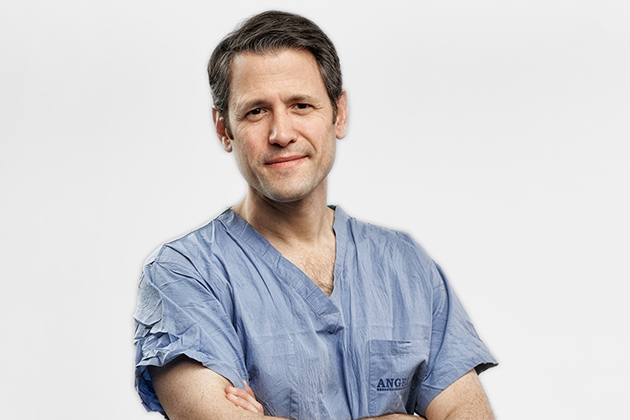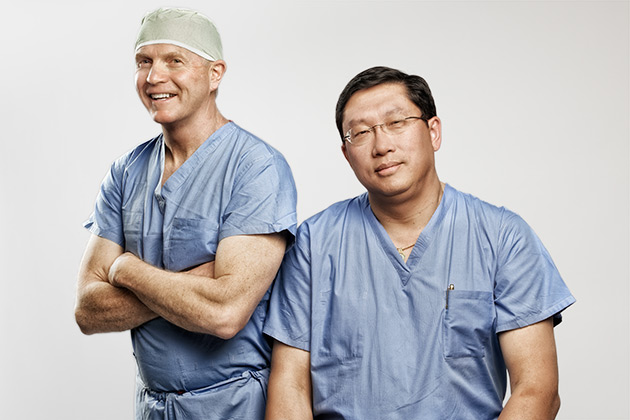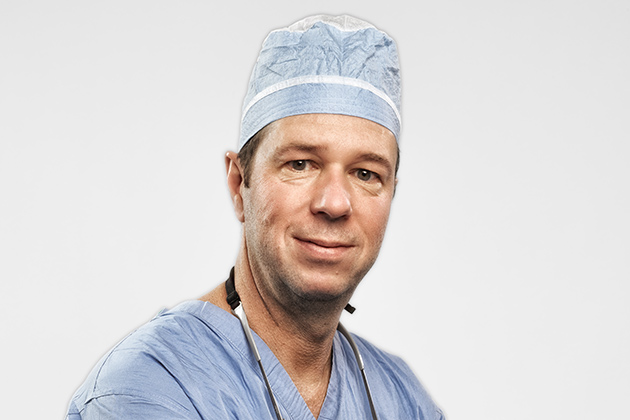Published On January 31, 2017
THOMAS MANNING SAW NO reason to be silent about the cancer that developed in his penis, or the genital amputation that was his only chance to stop it from becoming more serious. “I never hid it from anybody,” he says. And the same candor guided Manning when he chose to become the first man in the United States to receive a penis transplant last May. He chatted with reporters and gave a thumbs up to photographers as he recovered from his surgery in a bed at Massachusetts General Hospital. “When I lost it, I wasn’t ashamed,” he says. “When I got it back, why should that be any different?”
Manning’s attitude helped humanize a surgical milestone, a complex procedure made possible by dramatic changes in the concept of transplantation that have taken hold over the past generation, to say nothing of the determination of physicians who ignored skeptical colleagues. Such transplants may offer help to victims of injury, disease or genetic anomalies that have left them feeling less than whole. The surgery may also aid wounded warriors returning home with severe trauma to their genitals, a subset of young veterans who are much more likely to commit suicide than their peers.
As life-changing as genital injury can be to male patients, it remains largely invisible to outsiders, says urologist and transplant surgeon Dicken Ko, director of regional urology at MGH and former surgical director of kidney transplantation. That reality moved Ko to discuss the possibility of a penile transplant with a colleague, plastic surgeon Curtis Cetrulo, director of MGH’s Vascularized Composite Allotransplantation Laboratory. “What struck us was that these people are suffering in silence,” says Ko.
Manning’s bravery in speaking out, and the surgical team’s willingness to attempt a new procedure—one that took years of preparation and the contribution of more than four dozen clinicians—may help change all of that. One man’s transplant could not only aid countless men but also help fight the stigma and sense of loss that so many of them live with.

IN LATE JANUARY 2012, Tom Manning was working as a courier for a bank in Boston’s financial district. He slipped on an icy ramp one morning, and the heavy hand cart he was pushing landed on top of him, injuring his groin. About two months later, when the injury was still painful, he sought treatment at MGH, where an exam revealed bruised and swollen genitals and a hematoma—a collection of blood—in his scrotum. But the doctor examining Manning also noticed that the tip of his penis felt unusually firm. MGH urologic oncologist Adam Feldman performed a biopsy, which confirmed Feldman’s suspicion: Manning had squamous cell carcinoma of the penis, or penile cancer.
About 2,000 men in the United States were diagnosed with penile cancer in 2016, according to the American Cancer Society. In Manning’s case, the malignancy had deeply invaded the tissue of his penis, and Feldman had no choice but to amputate most of it, leaving a stump of just a few centimeters.
After surgery, Manning urinated through a catheter while he healed. But when the catheter was removed, he found that he had difficulty urinating while standing up—his urine would spray, often staining his clothes. Frustrated, he began searching the Internet for a solution. During a routine office visit, Manning told Feldman, “If you guys ever do a penis transplant, I want to be your guy.” His entreaties continued during subsequent visits, but Feldman always had to tell his patient, “We’re not doing that yet.”
BUT THE TIME WAS drawing closer. Transplanting external tissue from one person to another was long thought to be impossible because the body particularly and aggressively rejects skin not its own. However, new immune-suppressing drugs in the 1980s and 1990s helped overcome that problem. The first successful hand transplant was performed in 1998, and the first face transplant in 2005. These complex procedures, involving skin, bone, muscles, blood vessels, nerves and connective tissue, have become known as vascularized composite allografts, or VCAs.
In 2006, surgeons in China transplanted the penis of a brain-dead male, age 22, onto a 44-year-old man who had a “traumatic penile defect.” (Citing “severe psychological” distress by the recipient and his wife, doctors amputated the graft two weeks later.) Before news of this operation circulated, however, Ko had begun to consider the prospect of performing penile transplants. VCAs had pushed transplantation in a new direction, because—unlike solid organ transplants—they aren’t life-saving, yet require patients to take potentially toxic immunosuppressing drugs for life.
Undaunted by colleagues who felt that transplanting a penis was ill-advised or inappropriate, Ko approached Cetrulo in 2012—after he and his team had performed MGH’s first hand transplant—and began to discuss the possibilities. They were spurred on by the arrival of Glen Barrisford, a new urologic oncology fellow at MGH, who had been a U.S. Navy Commander and worked at the National Naval Medical Center, which eventually became the Walter Reed National Military Medical Center in Bethesda, Maryland. Barrisford had been part of a team that treated more and more men coming back from Iraq and Afghanistan with severe genitourinary trauma. “We were seeing injuries we had not seen before, and quite frankly, we didn’t know what to do with them,” says Barrisford, now a urologic oncologist at Kaiser Permanente in Santa Rosa, California.
There is a procedure called penile reconstruction, or phalloplasty, in which a surgeon excises a “flap” of skin, fat and other tissue, often from the forearm or leg, and uses it to form something resembling a penis that can be sutured into place. The graft allows a man to urinate and may eventually develop sensation. For a man with such a graft to get an erection, however, requires penile prostheses, and infections and other complications are common. And even the most skilled plastic surgeon can only approximate the appearance of a natural penis.
The transplant of a donor penis might be an improvement. But before Ko and Cetrulo could move forward, they needed the approval of the MGH institutional review board (IRB), which grants permission for experimental procedures. In June 2014, the surgeons submitted a detailed proposal that explained how they would perform a penile transplant and why the procedure would fill an important need—providing a natural appearance that couldn’t be achieved through reconstructive surgery; restoring full urinary function, including the ability to urinate while standing; and, possibly, reestablishing sexual function.
The IRB sent back the proposal several times with questions and comments. “They kept saying, ‘Nobody has done this before,’” says Ko. (The board, and most Western doctors, discounted the 2006 transplant in China because so little was known about it.) But in late 2014, doctors from Stellenbosch University and Tygerberg Hospital in Cape Town, South Africa, transplanted a penis for a 21-year-old patient who had been mutilated in a ritual circumcision. Only a couple months after the transplant, the young man had regained the ability to have sex. (It was reported that he got his girlfriend pregnant in early 2015.) Ko and Cetrulo amended their IRB proposal, noting the success of that surgery. In December 2015, the IRB gave its approval.
That step meant Ko and Cetrulo could ask the New England Organ Bank (NEOB)—one of 58 federally designated organ-procurement organizations—to be prepared to help them identify donors once they were ready to perform the procedure. Yet while the dawn of the VCA era has meant that a wider range of patients can now benefit, many in the donor community have worried that the families of potential donors might be uneasy about procuring tissue not hidden inside the body. “People don’t commonly think about donating faces or hands or penises,” says Alexandra Glazier, president and CEO of NEOB. But half of the families NEOB has approached about donating VCAs from deceased loved ones have said yes.
Meanwhile, Ko and Cetrulo assembled a multidisciplinary transplant team, which included numerous surgeons, urologists and specialists. The surgeons began dissecting cadavers to better understand the intricacies of penile anatomy and rehearse a transplant. Yet they still lacked a patient.
One Friday night in February 2016, Tom Manning got a phone message from Adam Feldman, asking him to call back as soon as possible. Manning had seen his physician for a checkup and had blood drawn earlier in the week, and his first thought was, My cancer has returned. Instead, Feldman surprised him by asking whether he was still interested in receiving a penile transplant. “Let’s just do it,” said Manning.

Manning met with Ko and Cetrulo, who were impressed by his upbeat personality and good health, and felt his circumstances made him a good candidate for a possible transplant. “He was distraught about his appearance and his inability to urinate while standing, not to mention having no further opportunity for intimacy in his life going forward,” says Ko. “Those were exactly the problems we seek to help solve.”
An MGH psychiatrist then met with Manning and deemed him psychologically prepared. “The patient needs to understand that there are long-term, lifetime risks,” says Cetrulo. “He needs to be motivated to take medications as directed and come in for treatment.” Manning also underwent a thorough physical examination. A cardiologist found that his aortic valve might eventually need replacing, but his heart was stable and healthy enough for transplant surgery.
Cetrulo and Ko had continued to screen other potential transplant recipients, and they identified one other candidate. But in early May, the NEOB called Cetrulo to say the family of a man who had been declared brain-dead had granted permission for his penis to be donated for transplant, and the donor’s blood type, skin tone and other immunological characteristics were a good match for Manning.
There was one problem. Ko and most of the rest of the MGH urology department were 3,000 miles away, in San Diego, attending the American Urological Association’s annual conference, and Ko was slated to moderate a scientific transplant session on Saturday, when the transplant would likely occur. Ko called urological surgeon Frank McGovern at MGH and asked him to step in. Ko also called Kai Li, a second-year urology resident who hadn’t yet left for San Diego, and asked him to be ready to take part, too. Then Ko booked the earliest flight to Boston for Saturday night.
THE MGH TRANSPLANT CENTER called Manning Friday with the news, telling him to line up a ride to MGH for the next morning and not to eat or drink anything for the rest of the night. Manning’s phone rang around 8 a.m.—the surgery was on.
Everyone who would be involved in the transplant assembled in a conference room to review the step-by-step plan. There would be two teams—one to prepare Manning for the transplant, and a second to travel a few hours north to get the tissue to be transplanted. At noon, a NEOB organ surgical recovery coordinator picked up the donor team—which included Cetrulo, three other plastic surgeons and Li—at MGH for the drive.
Beginning at around 6 p.m., the surgeons at the donor’s site worked together to remove the donor’s penis along with tissue from the pubic region, including blood vessels and nerves. They started by excising tissue flaps on either side of the penis, taking care to include delicate arteries that would connect the graft to Manning’s circulatory system. Finally, they separated the penis from the attachments to the pubic bone. The entire VCA organ was flushed with a preservation solution and wrapped in a sterile container, which they placed on ice in a cooler for the trip to MGH.
In Boston, the second surgical team prepared Manning. Because urine tended to dribble from the stump of his penis, its tip was inflamed and irritated, and tissue inside was scarred. Surgeons trimmed away slices of the stump to expose healthy tissue where the new penis would be attached. They also removed scar tissue from the tip of the urethra, which carries urine from the bladder. Then they identified the main arteries and veins running through the stump and tagged them with small clips for identification.
When the donor team arrived, well after 10 p.m., the transplant began. The strongest tissues in the penis are the corpora cavernosa—two side-by-side cylinders of sponge-like tissue that fill with blood to create an erection—and the corpus spongiosum, the lower portion of the penis through which the urethra passes. McGovern aligned that tissue in the donor penis with Manning’s, then used strong, absorbable sutures to stitch together only the undersides of each matching structure, leaving the tops open so that the surgeons could connect the remaining tissues.
McGovern and a colleague slid a catheter into the donor penis’s urethra to ensure that it was open and free of blockages, then inserted the other end into Manning’s urethra. They sutured together the two parts, leaving the catheter in place to provide scaffolding and ensure stability. (It was removed three weeks later after X-rays confirmed healing.)
Cetrulo and several other plastic surgeons, using microscopes and sutures as fine as an eyelash, took turns painstakingly connecting all the necessary arteries, nerves and veins. At around 1 a.m., Manning’s blood began circulating through the donor penis. “That was a great moment,” McGovern says.

Meanwhile, flying back to Boston, Ko used airline Wi-Fi and two smartphones to continually call and text his colleagues in the operating room and to relay updates to those team members on the West Coast. When he got to MGH he scrubbed in and joined the team in the operating room. It was already crowded with anesthesiologists and nurses, and along one wall sat a half dozen surgeons, all waiting to do their part. Probably 50 people had a role in the 15-hour procedure.
By the time Ko arrived, it was clear that there was inadequate blood flow through the dorsal artery, along the top of the penis, likely because of scar tissue in Manning’s part of the blood vessel, which had been tied off for four years. The team had anticipated that possibility, says Cetrulo, and another group of surgeons harvested a blood vessel from Manning’s right foot. The replacement vessel was then grafted into the donor penis and connected to Manning’s right femoral artery.
“That maneuver established additional robust blood flow,” says Cetrulo. Surgeons next closed the corpora cavernosa and corpora spongiosum, and then attached the two dorsal nerves, which run parallel to one another on the top of the penis. Again, using a microscope, surgeons gently stitched the two nerves of the donor penis to Manning’s. The hope was that the nerves would grow, branch out and eventually provide sensation.
As daylight filled Boston’s streets, surgeons finally concluded the operation by suturing the skin of the donor penis to Manning’s body. He was then transferred to the 14th floor intensive care unit for recovery and rest. The operation that began at the dinner hour on Saturday evening had ended just in time for Sunday brunch on Mother’s Day.
After the operation, Kai Li flew to San Diego to deliver a presentation the next day at the AUA meeting, on behalf of the MGH penis transplant team, about preoperative evaluation of transplant candidates. “Everybody in attendance was extremely interested,” says Li. But they all had the same question: How do you know this will work if you haven’t done a transplant? “I had to bite my lip,” he says. “I wasn’t allowed to say anything because we didn’t want to leak news until we knew the patient was doing well.”
Yet the patient was indeed doing fine, despite a minor setback or two. The day after surgery, bleeding around the graft was quickly stopped but caused the tissue to bruise, making it difficult to see whether the skin was reddening—a possible early sign of organ rejection. But other indicators (such as monitoring of immune cells) suggested that Manning’s body was indeed accepting the VCA.
A little more than a week after the operation, MGH held a press conference announcing the first penile transplant performed in the United States. Manning didn’t attend, but he agreed to have his photograph released and was soon granting interviews. And he has never shied away from discussing his surgery.
“I’m happy with the progress,” says Manning, back at the home he shares with his mother, Florence, in the small town of Halifax, Massachusetts, about an hour south of Boston. He cites a milestone—urinating while standing—that he reached shortly after the temporary catheter was removed from his penis. Ko took Manning into a men’s room where he’d set up a target inside a toilet bowl as a standard urine flow test. “Hit that bull’s eye,” said Ko, closing the door of the stall. Manning stood alone for a moment, then Ko heard the good news. “First time in four years!” exclaimed Manning.
Three months after the operation, Manning began to gain sensation in his penis. “Which is phenomenal,” says Ko, noting that he and Cetrulo had expected that milestone to come much later. A return of sexual function, if it happens, could take as long as a year, Ko estimates.
Eighty-five percent of VCA transplant patients experience some degree of allograft rejection during the first year, usually about a month after the transplant. And, in fact, four weeks after Manning’s operation the skin around the graft became inflamed, suggesting an immune system attack. Readmitted to MGH, he received steroid therapy and had his immunosuppressive drug regimen adjusted. That brought the problem under control and he hasn’t had any rejections since.
Other problems, including elevated potassium levels, have also sent Manning back to the hospital. That’s a common side effect of tacrolimus, one of his immunosuppressing medications. Taking his many drugs sometimes saps him of energy, especially on hot days, and Manning realizes he’ll likely have to live with such issues and require scheduled medical attention for the rest of his days. “But that’s okay,” he says. “I bought into that.”
WHERE MANNING LED, OTHERS will soon follow. Last fall, with Manning progressing well, Ko and Cetrulo prepared to perform a second penile transplant. And at Johns Hopkins, a team led by plastic surgeon Richard Redett III was hoping to perform that hospital’s first such procedure before the end of the year, for a soldier injured in the Middle East. Initially, the Hopkins group will consider only men who have suffered genital trauma and can’t undergo penile reconstruction. Redett, however, believes that improvements in immunosuppression could eventually mean the surgery might be offered to boys and young men with congenital conditions that have left them with ambiguous or deformed genitalia.
And there may be other candidates. Could a transgender man—a biological woman who identifies as male—be a candidate for a penile transplant? As the ability to perform such surgery becomes more widespread, that is just one of the questions that will need to be addressed, says bioethicist and social worker Laura Kimberly, an assistant research scientist at New York University Langone Medical Center’s department of plastic surgery. Kimberly, who co-authored an article about the ethics of penile transplants in the journal Transplantation last July, notes that medical societies will need to craft guidelines for the procedure.
So while it may take time, Manning seems likely to become part of a brethren who suffered every man’s worst fear, but—in a phrase often heard when penile transplants are discussed—are able to become whole again. Manning says he hopes to give talks to wounded veterans and one day to write a book about his experience. “I believe everybody gets knocked down and you get back up,” he says.

Dossier
“The History of Human Composite Tissue Allotransplantation,” by G.R. Tobin et al., Transplantation Proceedings, March 2009. The authors examine the evolution of composite tissue transplant surgery.
“The Ethics of Penile Transplantation: Preliminary Recommendations,” by A.L. Caplan et al., Transplantation, July 2016. Penile transplants raise ethical questions that call for the creation of thoughtful guidelines.
“Evaluation and Treatment of Genital Injuries in Combat Warriors,” a symposium sponsored by the Walter Reed National Military Medical Center in 2012. Essays for the symposium explore the psychiatric and medical risks of genital injuries among wounded soldiers.
Stay on the frontiers of medicine
Related Stories
- More Faces Saved
Recent procedures bring new hope to face transplant candidates.
- The Transplant Trick
An experimental protocol fools the immune system into accepting a new organ without debilitating drugs. Could it become routine?
- That's Some Pig
Sugar-free and engineered for tolerance, hogs may one day fill a need for transplant organs.